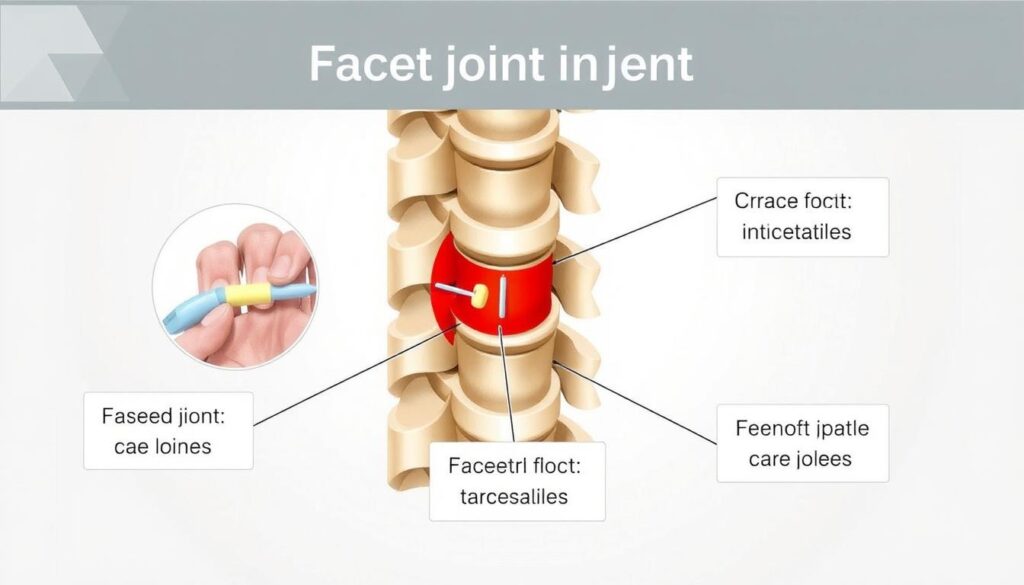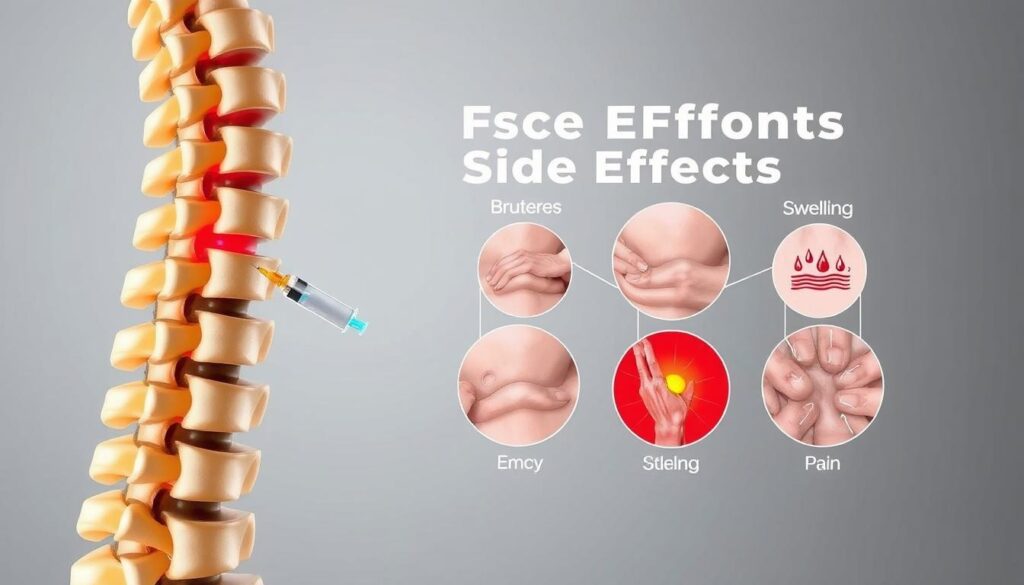
Facet joint injections are often used to treat spinal pain. This includes conditions like facet joint arthritis or lumbar facet syndrome. At Liv Hospital, we know how important it is to know about the possible problems with this treatment. Learn about 10 important nerve damage from facet joint injections, including nerve damage.
Facet joint injections can help with pain, but it’s key to know the risks and side effects. As a leader in safe care, we aim to give you the info you need. This way, you can make smart choices about your treatment.
Knowing about the possible side effects and risks helps you choose the best treatment. It also lets you work closely with your doctor to find the right plan for you.

Facet joint injections are a treatment for chronic pain. They help reduce pain and inflammation in the spine.
Facet joints are small joints between vertebrae. They help the spine move and stay stable. If they get inflamed, they can cause a lot of pain.
These injections have steroids and anesthetics. They give quick and lasting relief.
Facet joint injections target different parts of the spine. The main types are:
| Type of Injection | Region of Spine | Purpose |
| Lumbar | Lower Back | Treats lumbar region pain |
| Cervical | Neck | Treats neck pain |
| Bilateral | Both sides of the spine | Treats pain on both sides |
The procedure is done under X-ray to ensure it’s accurate. You’ll lie on your stomach or side, depending on where you need the injection. The area is cleaned and numbed with a local anesthetic.
The whole thing usually takes less than 30 minutes. You might be able to go home the same day.
Knowing about facet joint injections helps you prepare. It tells you what to expect during and after the treatment.

Knowing the common side effects of facet joint injections is key for patients. These injections are usually safe, but it’s good to know what might happen after. This helps patients make better choices about their care.
Local pain and tenderness at the injection site are common. This pain is usually mild and goes away in a few days. To ease this, try applying ice and taking over-the-counter pain relievers.
Swelling and bruising at the injection site can also happen. These are minor and short-lived, gone in a week. To help, elevate the area and use gentle compression.
A less common but notable side effect is the “steroid flare.” This is a temporary pain increase due to the steroid. It can be managed with pain relief and rest. The flare usually goes away in a few days.
It’s important for patients to know about these possible side effects. Talking to their healthcare provider about any concerns is vital. Understanding what to expect helps patients navigate their recovery and make informed decisions.
Many patients feel a temporary spike in pain after facet joint injections. This can be due to several reasons. It’s important to understand why this happens.
A “steroid flare” is a temporary pain increase from the steroid in facet joint injections. This usually lasts a few days. It happens because the steroid irritates the tissue before it starts to reduce inflammation.
The needle used in injections can also cause pain. Minor trauma from the needle can lead to temporary pain. This pain is usually near the injection site.
While steroid flare and needle irritation are usually harmless, sometimes increased pain is a sign of a bigger issue. If pain is severe, lasts long, or comes with numbness, tingling, or fever, get medical help right away.
| Signs of Possible Complications | Action Required |
| Severe pain | Seek immediate medical attention |
| Prolonged pain | Consult your doctor |
| Numbness or tingling | Contact your healthcare provider |
| Fever | Seek medical help immediately |
Knowing why pain might increase after facet joint injections can ease worries. It ensures patients get the right care when needed.
It’s important to know the possible side effects of lumbar facet injections. These injections help with lower back pain from the facet joints. While they are generally safe, they can cause several side effects.
One common side effect is an increase in back pain. This can happen because of the injection or the corticosteroid used. It’s key for patients to know that a temporary pain increase is possible, and it usually goes away on its own.
Numbness and tingling in the lower legs can also happen. This is often because the needle hit a nerve or the corticosteroid affected nerve function. Patients should tell their healthcare provider about these symptoms as they might need more checks.
Injections at the L4-L5 level are more concerning because of the risk to vital structures. There’s a chance of nerve damage or irritation that could cause ongoing pain or neurological issues. Talking with a healthcare provider about the risks and benefits is very important.
To understand the side effects and how to manage them, let’s look at the table below:
| Side Effect | Frequency | Management |
| Back Pain Exacerbation | Common | Conservative management with pain medication |
| Numbness/Tingling | Less Common | Monitoring; may require physical therapy |
| Nerve Damage | Rare | May require further medical intervention or surgery |
Knowing the side effects of lumbar facet injections is key to making good choices about your care. By understanding these risks, patients can make better decisions and talk about any worries with their healthcare provider.
Bilateral lumbar facet injections help with pain but also have risks. It’s important to know the possible complications, mainly with bilateral injections.
Facet joint injections on both sides can lead to more side effects. This is because you’re injecting into two spots, which might increase the risk of reactions.
Common side effects that may be more pronounced with bilateral injections include:
Knowing these side effects helps manage expectations and make informed choices.
Bilateral lumbar facet injections can make moving harder. The injections might cause stiffness or discomfort in the lower back.
“Patients may experience a temporary reduction in mobility due to the injections, which can be managed with appropriate post-procedure care and rehabilitation exercises.”
It’s important to be aware of these mobility challenges. Plan ahead, maybe arrange for help if needed.
Recovering from bilateral lumbar facet injections needs careful thought. Be ready for more discomfort and follow instructions closely to avoid complications.
Key recovery considerations include:
Understanding the risks of bilateral lumbar facet injections helps prepare for the procedure and recovery. This way, patients can make better decisions about their care.
Before getting cervical facet injections, it’s good to know the possible side effects. These injections help with neck pain but have risks like any treatment.
Neck discomfort or stiffness is a common side effect. This can happen from the injection or the medicine used. Luckily, this usually goes away quickly.
Headaches or dizziness can also happen after these injections. These symptoms are usually mild but can sometimes be severe.
A serious but rare risk is injury to the vertebral artery. This artery is near the facet joints in the neck. If it’s accidentally hit or injected into, it can cause serious problems like stroke.
To understand the risks better, let’s look at some data:
| Side Effect | Frequency | Typical Duration |
| Neck Discomfort | Common | Temporary (days to weeks) |
| Headaches | Less Common | Variable (hours to days) |
| Dizziness | Less Common | Variable (hours to days) |
| Vertebral Artery Injury | Rare | Variable (potentially permanent) |
Talking to your healthcare provider about these side effects is key. They can help you understand the risks and benefits. This way, you can make the best choice for your health.
Facet joint injections can help with pain but also carry a risk of nerve damage. It’s important to know about this risk before you decide to get the treatment. Medical procedures can be scary, and knowing the possible problems is key.
Nerve injury can happen during facet joint injections for a few reasons. The area around the facet joints is close to important nerves. This means the needle could accidentally hit or harm these nerves.
Mechanical irritation or direct trauma from the needle can lead to nerve damage. This can cause a variety of symptoms. Also, the medicine used in the injection can spread to nearby nerves, causing irritation or damage.
We stress the need for careful technique and the use of imaging during the procedure. This helps lower the risk of nerve injury.
It’s important to know the signs of nerve damage. Look out for numbness, tingling, or sharp pain along the nerve path. You might also notice muscle weakness or loss of reflexes in the affected area.
If you notice these symptoms after a facet joint injection, tell your doctor right away. Quick action can help figure out the cause and find the right treatment for nerve damage.
The effects of nerve injury from facet joint injections can vary. Sometimes, the damage might be temporary and get better with time or treatment. But, persistent or permanent nerve damage can cause long-lasting symptoms that can really affect your life.
We suggest talking to your doctor about your risks and any worries you have before getting facet joint injections. Knowing the possible risks and benefits helps you make a better choice for your health.
Facet joint injections are usually safe, but there’s a small chance of getting an infection. It’s important for patients to know about this risk. They should also know how to spot and handle it.
An infection after a facet joint injection can show in different ways. Look out for increased redness, swelling, and pain at the injection spot. Also, watch for fever and chills.
It’s key for patients to keep an eye on how they feel after the procedure. If they notice any of these signs, they should see a doctor right away.
If an infection happens, it’s important to treat it quickly to avoid bigger problems. Usually, treatment means antibiotics to fight the infection. Sometimes, draining the infected area is also needed.
| Treatment Option | Description |
| Antibiotics | Medications used to treat bacterial infections |
| Drainage | Procedure to remove infected fluid or material |
| Monitoring | Close observation of the patient’s condition |
While we can’t get rid of the infection risk completely, there are ways to lower it. Prevention steps include making sure the injection area is clean, using sterile tools, and following care instructions after the procedure.
By knowing the risks and taking steps to prevent them, patients can lower their chance of getting an infection after a facet joint injection.
Facet joint injections can cause more than just local side effects. They can lead to allergic reactions and affect the body in other ways. It’s important to know about these risks.
These injections often include corticosteroids. These can change blood pressure and blood sugar levels. People with diabetes or high blood pressure need to be careful.
They should watch their blood pressure and sugar levels after the injection. This is important for their health.
Corticosteroids can also affect mood and sleep. Some people might feel more irritable or even happy. Others might have trouble sleeping.
These changes can be hard to deal with. If you’re having mood swings or trouble sleeping, talk to your doctor.
Allergic reactions to facet joint injections are rare but can happen. Symptoms include rash, itching, swelling, and trouble breathing. If you see these signs, get help right away.
It’s key to spot allergic reactions early. Tell your doctor about any unusual symptoms quickly.
It’s important to know how well facet joint injections work and for how long. We’ll look at how long the pain relief lasts, how often it works, and what affects its success.
Facet joint injections can help with pain for several months. How long it lasts depends on the person’s condition and health.
Research shows the relief can last from weeks to months. Sometimes, it lasts a long time, and other times it’s short-lived.
The success of facet joint injections varies. It depends on the condition and the person’s health history. Most people find it helps with pain, but it’s not always the same for everyone.
| Study | Success Rate | Duration of Relief |
| Study 1 | 60% | 3-6 months |
| Study 2 | 70% | 6-12 months |
| Study 3 | 50% | 1-3 months |
Many things can change how well facet joint injections work. These include how bad the condition is, the person’s health, and how well the injection is done.
Key factors affecting treatment outcomes include:
Knowing these factors helps patients understand what to expect. It helps them make better choices about their treatment.
Facet joint injections can help manage chronic pain. But, it’s key to know the good and bad sides. We’ve looked at the side effects and risks, like pain, swelling, and serious issues like nerve damage and infection.
These injections can bring a lot of relief from pain. Yet, patients should think about their own situation and talk to a doctor. Knowing the benefits and risks helps patients choose the right treatment for their pain.
Choosing facet joint injections should be a careful decision. It’s important to weigh the benefits against the risks and consider other options. Working with a healthcare provider helps find the best treatment for each person’s needs. This way, they can manage their pain effectively.
Facet joint injections help diagnose and treat spinal pain. They involve injecting a local anesthetic and/or corticosteroid into the facet joint. This reduces pain and inflammation.
Common side effects include pain and tenderness at the injection site. You might also see swelling, bruising, and a temporary increase in pain.
Pain can worsen due to steroid flare or mechanical irritation. It can also signal a problem, like infection or nerve damage.
Lumbar facet injections can cause back pain, numbness, and tingling in the lower extremities. L4-L5 facet injections have specific concerns.
Yes, bilateral lumbar facet injections have a higher risk of side effects and mobility challenges.
Cervical facet injections can cause neck discomfort, headaches, and dizziness. Rarely, they can lead to vertebral artery injury.
Yes, facet joint injections can cause nerve damage. Watch for persistent numbness, tingling, or weakness.
Signs of infection include increasing pain, redness, swelling, warmth, fever, and chills. Seek medical attention if you notice these symptoms.
Systemic side effects include blood pressure and blood sugar changes, mood swings, and sleep issues. Allergic reactions are also possible.
Relief from pain can last weeks to months. Success and duration vary based on individual factors.
Success depends on the accuracy of the injection, the cause of pain, and individual patient characteristics.
Follow instructions carefully before and after the procedure. Report any unusual symptoms to your healthcare provider. Ensure your procedure is done by an experienced practitioner.
Subscribe to our e-newsletter to stay informed about the latest innovations in the world of health and exclusive offers!
WhatsApp us